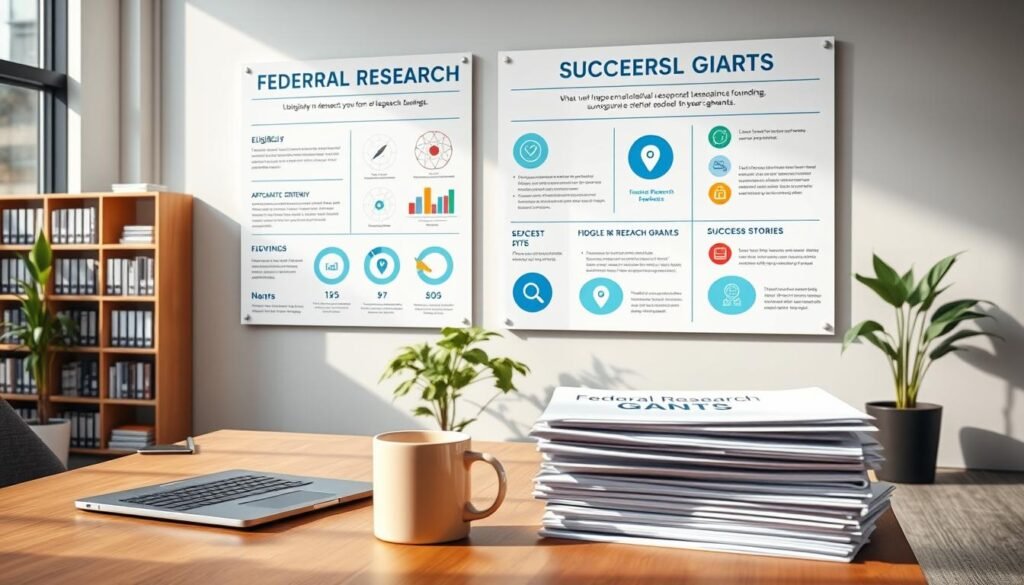Did you know that federal funding opportunities exist to help small businesses grow, but not in the way most entrepreneurs expect? While many assume these programs provide startup capital, the reality is more specialized. The Small Business Administration (SBA) offers targeted grants designed to fuel innovation, community development, and export growth—not direct business funding.
These programs primarily support scientific research, local entrepreneurship initiatives, and companies expanding into global markets. If you run a nonprofit, veteran-owned enterprise, or research-focused organization, you might qualify for these competitive awards. Understanding the four main grant types and their strict eligibility criteria is crucial before applying.
Key Takeaways
- SBA funding focuses on research, community projects, and export growth
- Startup costs and business expansions typically don’t qualify
- Four primary grant types support different development goals
- Nonprofits and research entities often meet eligibility requirements
- Application processes vary by program type
What Are SBA Grants?
Federal programs focus on strengthening entrepreneurship ecosystems rather than individual businesses. These awards fund nonprofits, educational institutions, and resource partners that provide training or counseling. Direct cash for startups or expansions isn’t typically available.
Legitimate communications only come from @sba.gov email addresses. This helps prevent fraud—a critical detail since scams often mimic government offers. Always verify the sender before sharing sensitive data.
The Made in America Manufacturing Initiative is one example. It backs workforce development but channels funds through local organizations. This indirect approach ensures broader community impact.
Unlike loans, these awards don’t require repayment. However, they’re highly competitive and tied to specific goals like research or export growth. Understanding this distinction helps businesses identify the right programs for their needs.
Do SBA Grants Fund Business Startups?
Starting a business often requires creative financing since government grants rarely cover initial expenses. The Small Business Administration explicitly states it doesn’t award funds for launching or expanding small businesses. Instead, its programs target research, exports, and community development.
Entrepreneurs should explore alternatives like personal savings, angel investors, or traditional loans. The SBA’s loan programs, such as 7(a) or microloans, often better suit startup needs than business grants.
Specialized initiatives exist for women-owned, minority-owned, and rural businesses. Military spouses and agricultural enterprises may qualify for Farm Service Agency loans or state-level incentives.
Free training and counseling are available through SBA resource partners. These services help navigate funding options without the false hope of startup grants.
Types of SBA Grants Available
Manufacturers and researchers can access unique funding opportunities through federal initiatives. These programs prioritize technical assistance and workforce development over general business expenses. Below are four key grant types designed to strengthen specific sectors.
1. Research & Development Grants (SBIR and STTR Programs)
These awards fund scientific innovation. Small businesses in tech or biotech often qualify. The focus is on projects with commercial potential.
2. Community Entrepreneurship Grants
Local nonprofits and educational institutions receive funds to support startups. Programs include hands-on training and mentorship for underserved entrepreneurs.
3. State Trade Expansion Program (STEP)
This helps businesses enter global markets. Funds cover export costs like trade shows or marketing. States administer the program locally.
4. Made in America Manufacturing Initiative
This boosts domestic manufacturing competitiveness. Grants modernize equipment and retrain workers. Partnerships with technical colleges are common.
Eligible manufacturers must show how funds will improve productivity. Workforce development plans are a key requirement.
Who Is Eligible for SBA Grants?
Federal awards target specific groups, from nonprofits to innovators in scientific research. Eligibility hinges on your organization’s mission, partnerships, or alignment with national priorities like technology or export growth.
Nonprofits and Educational Organizations
Community-focused entities often may qualify for funding. Programs prioritize nonprofits that provide entrepreneurship training or rural development services. Universities partnering with small businesses for federal research also meet criteria.
Veteran-Owned and Service-Disabled Veteran-Owned Businesses
Veterans may qualify for specialized initiatives. These programs support business development, often requiring proof of military service. Partnerships with SBA resource partners can strengthen applications.
Small Businesses Engaged in Scientific Research
Tech and biotech firms pursuing scientific research with commercialization potential are ideal candidates. The SBIR/STTR programs evaluate:
- Phase I: Feasibility studies (up to $250,000)
- Phase II: Prototype development ($1M+)
- Phase III: Market-ready products (no funding cap)
Compliance with federal research lab collaboration rules and intellectual property plans is mandatory. Universities must hold at least 30% of STTR project work.
How to Apply for SBA Grants
Navigating federal funding applications requires precision—here’s how to avoid costly mistakes. Each program has unique requirements, from eligibility checks to documentation. Follow these steps to submit a competitive proposal while steering clear of fraud.
Step 1: Identify the Right Program
Match your project to the correct funding opportunity. Research focuses on scientific innovation, while community grants support local training. Review guidelines to confirm alignment with your goals.
Step 2: Gather Required Documentation
Prepare tax records, business plans, and partnership agreements. Nonprofits need proof of nonprofit status. Double-check deadlines to ensure timely submission.
Step 3: Submit Your Application
Use only official communications channels like @sba.gov emails. Scammers often mimic government portals. Upload files in specified formats to avoid technical rejections.
Step 4: Follow Up and Avoid Scams
Track your application via verified platforms. Recognize red flags like upfront fee requests. Report fraud to the OIG Hotline if you suspect phishing.
- Verify sender addresses in all correspondence
- Use whistleblower protections if reporting misconduct
- Submit post-award reports to maintain eligibility
Where to Find More Help
Navigating funding options can be overwhelming, but expert guidance is available. Free training programs and counseling help entrepreneurs make informed decisions. Whether you need export advice or disaster recovery aid, these resources simplify the process.
Start with the SBA Answer Desk at 1-800-827-5722 for immediate questions. Their nationwide network of 63 district offices offers local support tailored to your region’s needs.
Key resources include:
- SCORE Mentorship: Free one-on-one business development coaching from retired executives.
- Export Assistance Centers: Guidance for entering global markets, including trade show funding.
- Disaster Recovery Grants: Specialized aid for businesses affected by natural disasters.
- District Office Locator: Find local support for permits, zoning, and funding applications.
For hands-on training programs, check community colleges partnered with the SBA. They often host workshops on financial planning and marketing strategies.
Conclusion
Finding the right funding path requires knowing what’s truly available. Small business grants favor nonprofits, researchers, and veterans—not general startups.
Always apply through official channels to avoid fraud. Double-check eligibility before investing time in applications.
If grants don’t fit, explore loans or entrepreneurship training. Many programs offer free support for business development.
Stay persistent. The right funding can transform your vision into reality.
FAQ
What types of financial assistance does the SBA offer?
The agency provides funding for research, training, and business expansion. Programs like SBIR, STTR, and STEP support innovation, trade, and manufacturing growth.
Can startups receive funding through these programs?
Most initiatives focus on established entities, but some training and resource centers help new entrepreneurs with counseling and development tools.
Who qualifies for these funding opportunities?
Nonprofits, veteran-owned businesses, and companies involved in scientific research may qualify, depending on the specific program requirements.
How do I apply for financial support?
First, identify the right program. Then, prepare necessary documents like business plans or research proposals before submitting your application.
Where can I get help with the application process?
Local development centers and government offices offer technical assistance, including workshops and one-on-one counseling for applicants.







